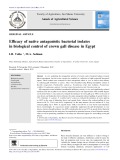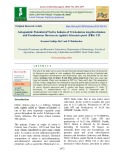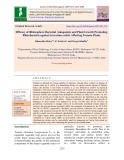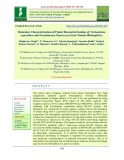
Native antagonistic bacterial isolates
-
In vitro analyzing the antagonistic activity of seventy native bacterial isolates towards plant tumorigenic Agrobacterium tumefaciens resulted in a selection of eight potential biocontrol agents. These isolates were screened for their antagonistic effect in vitro as well as their efficacy in reducing gall formation in planta.
 7p
7p  schindler
schindler
 30-12-2021
30-12-2021
 9
9
 0
0
 Download
Download
-
The aim of the study was to access the anti-bacterial and anti-fungal activity on the growth of Alternaria porri under in vitro condition. The antagonistic activity of bacterial and fungal antagonists (Pseudomonas and Trichoderma spp.) was determined by the dual culture technique both on King’s B and PDA media respectively, Paper disc assay and Agar well mathod. Plates were incubated at 28ºC for 7 days and 2 days. The antagonistic activity of these antagonists was evaluated by mycelial growth and mycelial dry weight of test fungus (Alternaria porri).
 6p
6p  chauchaungayxua5
chauchaungayxua5
 08-05-2020
08-05-2020
 15
15
 0
0
 Download
Download
-
Tomato is affected by a large number of diseases. Among these, collars rot disease of tomato cause by S. rolfsii is a threatening disease in eastern coastal regions of Odisha. Since, this disease is soil borne in nature, it is very difficult to control by chemical fungicides. The native rhizosphere soil of tomato was used for isolation and screening of bacterial antagonists for their efficacy and growth promotion potential. A total of 54 bacterial isolates were isolated from rhizosphere of tomato of which five isolates viz.
 12p
12p  trinhthamhodang3
trinhthamhodang3
 22-02-2020
22-02-2020
 26
26
 1
1
 Download
Download
-
The potent native bioagents isolated from tomato rhizosphere have high antagonistic potential against Phytophthora infestans. Molecular characterization of fungal isolates (T-11 and T-14) was performed by using Internal Transcribed Spacer (ITS) region of 18S rRNA sequence. The sequence analyses of two isolates (MK928414 and MK928417), showed 100% similarity with Trichoderma asperellum during BLAST analysis. The phylogeny tree constructed by using sequence analysis showed the formation of cluster along with T. asperellum and both the isolates were identified as T. asperellum.
 9p
9p  nguaconbaynhay3
nguaconbaynhay3
 07-02-2020
07-02-2020
 14
14
 0
0
 Download
Download
CHỦ ĐỀ BẠN MUỐN TÌM
















